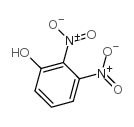2,3-DINITROPHENOL

2,3-DINITROPHENOL structure
|
Common Name | 2,3-DINITROPHENOL | ||
|---|---|---|---|---|
| CAS Number | 66-56-8 | Molecular Weight | 184.10600 | |
| Density | 1.65 g/cm3 | Boiling Point | 328.9ºC at 760 mmHg | |
| Molecular Formula | C6H4N2O5 | Melting Point | 143-146ºC | |
| MSDS | Chinese USA | Flash Point | 151.2ºC | |
| Symbol |



GHS06, GHS08, GHS09 |
Signal Word | Danger | |
| Name | 2,3-dinitrophenol |
|---|---|
| Synonym | More Synonyms |
| Density | 1.65 g/cm3 |
|---|---|
| Boiling Point | 328.9ºC at 760 mmHg |
| Melting Point | 143-146ºC |
| Molecular Formula | C6H4N2O5 |
| Molecular Weight | 184.10600 |
| Flash Point | 151.2ºC |
| Exact Mass | 184.01200 |
| PSA | 111.87000 |
| LogP | 2.25500 |
CHEMICAL IDENTIFICATION
HEALTH HAZARD DATAACUTE TOXICITY DATA
MUTATION DATA
|
| Symbol |



GHS06, GHS08, GHS09 |
|---|---|
| Signal Word | Danger |
| Hazard Statements | H301-H311-H331-H373-H411 |
| Precautionary Statements | P261-P273-P280-P301 + P310-P311 |
| Personal Protective Equipment | Eyeshields;Faceshields;Gloves;type P2 (EN 143) respirator cartridges |
| Hazard Codes | T: Toxic;N: Dangerous for the environment; |
| Risk Phrases | R23/24/25 |
| RIDADR | UN 1320 |
| RTECS | SL2700000 |
| Hazard Class | 4.1 |
| HS Code | 2908999090 |
| HS Code | 2908999090 |
|---|---|
| Summary | 2908999090 halogenated, sulphonated, nitrated or nitrosated derivatives of phenols or phenol-alcohols。Supervision conditions:None。VAT:17.0%。Tax rebate rate:9.0%。MFN tariff:5.5%。General tariff:30.0% |
|
The Role of Janus Kinase 3 in the Regulation of Na⁺/K⁺ ATPase under Energy Depletion.
Cell Physiol. Biochem. 36 , 727-40, (2015) Janus kinase-3 (JAK3) is activated during energy depletion. Energy-consuming pumps include the Na(+)/K(+)-ATPase. The present study explored whether JAK3 regulates Na(+)/K(+)-ATPase in dendritic cells... |
|
|
Neuroprotective effect of diphenyl diselenide in a experimental stroke model: maintenance of redox system in mitochondria of brain regions.
Neurotox. Res. 26(4) , 317-30, (2014) Acute stroke is a major risk for morbidity and mortality in aging population. Mitochondrion has been the focus of a wide stroke-related research. This study investigated if treatment or pre-treatment ... |
|
|
Tankyrases regulate glucoregulatory mechanisms and somatic growth via the central melanocortin system in zebrafish larvae.
FASEB J. 29 , 4435-48, (2015) The central melanocortin system is a key regulator of energy homeostasis. Recent studies indicate that tankyrases (TNKSs), which poly(ADP-ribosyl)ate target proteins and direct them toward proteasomal... |
| HOC6H3(NO2)2-2.3 |
| 2,3-DINITROPHENOL |
| anti-dinitrophenol |
| 2,3-dinitro-phenol |
| 2,3-DNP |
| 2,3-Dinitrofenol [Czech] |
| Phenol,2,3-dinitro |
| di-nitro-phenol |
| 2.3-Dinitro-1-hydroxy-benzol |